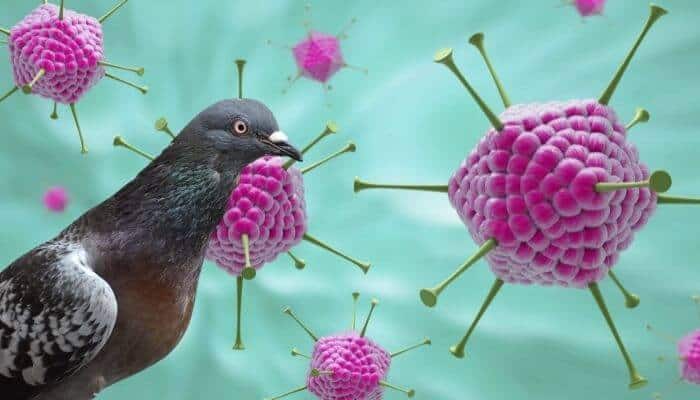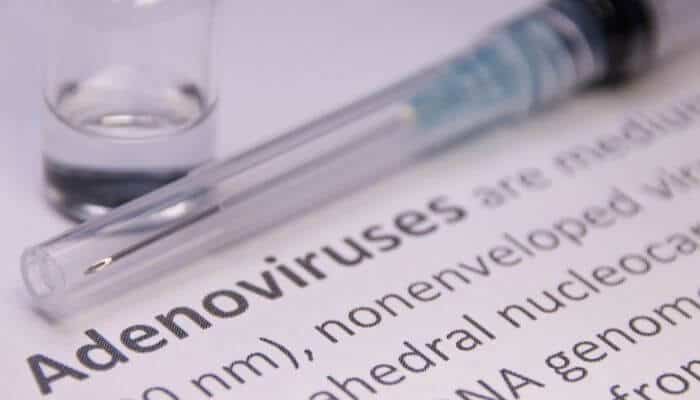Adenovirus is an infectious disease that mostly affects young birds, and that appears as a complex between a strain of this virus and a bacterial infection caused by Escherichia coli.
What Causes Adenovirus In Pigeons?
In the past, this viral disease used to be caused only by Adenovirus type I, a specific pathogen that affects the health of young pigeons.
However, in the past decades, the occurrence of Adenovirus type II, also known as necrotic hepatitis, has increased. This disease also affects adult birds.

Despite being one of the most contagious diseases of pigeons, the first form is typically not deadly. Young birds do tend to suffer from a variety of clinical signs, but they also tend to recover over the course of 5 to 10 days.
On the other hand, the second form of the disease is more dangerous and can sometimes be deadly if the spread is not contained and if the infected birds are not treated at the right time.
How Common is Adenovirus in Pigeons?
This viral infection has been reported in many places, especially in Europe. In most countries, there is a seasonal occurrence. The first cases appear from July to August, when young birds go out for their first flights.
A second season for the infection in ornamental and competitive pigeons exists, especially during the winter.
This also happens because when being transported to competitions, the pigeons are kept nearby one another, so sick birds can easily infect the rest due to close contact.
Causes of Adenoviruses in Pigeons
While the pathogen is released through droppings, so sharing the same living environment, as well as the same feeders and waterers, is the first cause of the disease, it is assumed that the virus is found in many bird populations.
In fact, some studies suggest that both types I and type II tend to affect pigeons in conditions that involve stress and poor hygiene.

The mortality of the disease can sometimes go up to 20% of the entire flock, while the morbidity can be as high as 80%.
Morbidity refers to the number of pigeons that are affected by the disease, but that might not necessarily die from it.
Symptoms
The typical clinical signs that can be seen in sick pigeons are mostly related to their gastrointestinal health.
Diarrhea and severe weight loss are the most significant symptoms that become noticeable.
There is an incubation period that exists between the time the bird has become infected and the moment it starts showing clinical signs.
What is extremely important about this disease is that it often evolves alongside other conditions.
This happens as a result of the pigeons’ immune system stopping to work properly because of the viral infection, which makes it possible for potentially pathogenic bacteria to cause health complications, too.
The infection is often named ‘Adeno-coli syndrome’ because Escherichia coli is a bacterium that is involved in the entire process, too.
Some other symptoms that can be noticed in infected pigeons are the following:
- Loss of appetite
- Ruffled feathers
- Vomiting (rare)
- Watery, brown, or green droppings
- A lack of reaction to sounds or birds nearby
- Severe weakening
If the pigeons do not receive any treatment, some might die in a matter of up to two weeks after showing the first symptoms.
While the primary pathogen is capable of causing necrotizing hepatitis by itself, this condition is also the result of the E. coli bacterium invading the liver.
Hepatic necrosis almost always causes the death of pigeons.
Older birds might be less vulnerable to E. coli infections so in their case, death could be a result of other potentially pathogenic bacteria causing secondary conditions, such as Staphylococcus or Streptococcus species.
Diagnosis
Isolating the pathogen can be quite complicated, and a differential diagnosis must be performed by the veterinarian to make sure that the pigeons are not, in fact, suffering from other diseases (such as Salmonellosis, Hexamitiasis, or Paramyxovirus).
In some countries, such as Germany or Belgium, where there is a specific seasonality of Adenovirus in pigeons, a diagnosis can be based on the clinical findings.
Transmission electron microscopy is the method that is typically used for a clear diagnosis, but few vets have access to it. In fact, TEM is usually available only at veterinary colleges and faculties, as well as specialized research facilities.
Classic histopathologic examinations can also be performed, and in this case, the diagnosis is based on the particular modifications inside the cells of the liver.
Multiple hepatocellular necrosis sites are revealed using this method, and some smears also reveal the presence of basophilic bodies inside the hepatocytes.
There are no other specific diagnostic tests available at this time.

This article was written by our qualified veterinarian Cristina.
This is part of our commitment to providing you with the most trustworthy veterinary advice for your pigeons.
Can Adenovirus in Pigeons Be Treated?
Even though treatment for this disease does not exist, there are some ways that pigeons can recover from Adenovirus.
First of all, in birds, in general, and also in pigeons, Adenoviruses almost never act alone.
While they can be considered primary pathogens, there are almost always contributing factors and organisms that cause hepatitis and a variety of gastrointestinal symptoms that occasionally lead to the birds’ death.
In most cases, the death cause is not represented by Adenovirus type I or II but rather by septicemia occurring as a result of the Escherichia coli infection.
It is true that Adenovirus type II is much more virulent compared to its counterpart, which is also why it can cause the death of adult pigeons in a matter of 24 to 48 hours after the first symptoms have become noticeable.

Considerable clinical improvement can happen after thanks to the administration of broad-spectrum medications such as antibiotics for E. coli, Staph, or Streptococcus infections.
In some countries, a combination of Colistin, Furazolidone, as well as Enrofloxacin have a number of benefits and can help some pigeons recover in a matter of just two to three days.
Because Adenovirus also tends to evolve alongside parasitoses, most birds will also have to be administered specific medications in this sense.
In fact, the mechanical action that parasites have on the intestinal mucous membrane makes it possible for the viral pathogen to find an entryway and infect the bird if it already exists in its system.
There are cases where a bird can have Coccidiosis, Adenovirus, and an E. coli infection all at the same time — and most of the time, a combination of these is lethal.
Survival Expectations & Recovery
These two are variable and largely depend on the general health of the birds themselves.
If the pigeons have ongoing infections and are immunocompromised, the mortality of that particular flock is going to be even higher than the typical 20% to 30% that most pigeon fanciers can expect.
Type I tends to be less virulent than type II, even though it affects young pigeons, which are generally more predisposed to developing severe symptoms.
Even so, in this age category, mortality is usually lower.
Type II is more aggressive, and since it affects adults, it causes death as a result of an acute form. In these cases, a prior infection with a bacterium or parasite might already exist, and the pigeon fancier might not have noticed it.
Many veterinarians recommend giving pigeons prophylactic medications for parasites and bacterial agents even if they do not necessarily have ongoing infections.
While this also increases the risk of antibiotic resistance, it also makes it less likely for the birds to suffer from severe symptoms if a viral infection does happen.
Even though Adenoviruses are present in many wild pigeons, too, they might not affect ornamental or racing ones if they are kept in good conditions, are fed the right type of food, and are accustomed to stressful conditions.
On top of that, stress seems to be a very important factor in the development of Adenovirus in pigeons, especially considering the seasonality of the disease — from March until July and during winter.
In the warmer months, racing pigeons tend to develop Adeno-coli syndrome, while in the colder season, birds can get it because their immune system is less capable of handling the abuse of the pathogen due to the low temperatures.
Prevention Of Adenovirus
Separating the birds from one another, especially those that are showing any clinical signs, is necessary to limit the spread of the virus and bacteria as much as possible.
However, this might not be effective every time, especially since, given the incubation period, by the time they start showing symptoms, the birds might have already infected the rest of the flock.
Sick birds should also not be used for racing as not only can their performance drop significantly, but they might also come in contact with other birds and put their health in danger, too.
Unfortunately, there is no completely effective way of preventing Adenovirus in pigeons. Pigeon aficionados are advised to practice excellent hygiene.
When introducing new birds into the flock, they should always be kept in quarantine for a minimum of 10 to 14 days to make sure that they are not carriers of various pathogens, including viral agents such as Adenovirus.
Using vitamin supplements and making sure that the birds are kept in good conditions, are warm enough, and are given sufficient nutritious food can be a way of preventing pigeon sickness in general.
Some vets also advise pigeon fanciers to use antifungal and immunomodulators on a regular basis for the same purpose.
While a vaccine against Escherichia coli does exist, it mostly tends to be used on chickens and turkeys.
There is a relatively new vaccine that might offer pigeons at least some protection against Adenovirus, and it is a triple biological product for Paramyxovirus, Herpesvirus, and Adenovirus.
Make sure you talk to your veterinarian about what options you have when it comes to preventing viral infections in pigeons, as they might have access to these products and could immunize your flock before the birds become infected.
Discussion
To date, there is no effective and specific treatment against Adenovirus in pigeons, whether for type I or II.
This means that the best weapon you have available if you are a pigeon fancier is to make sure that their living enclosures are kept in excellent condition.
Since birds tend to release the virus and the secondary pathogens, whether bacteria or parasites, through their body secretions, cleaning their living space is of utmost importance.
Also, pigeons can accidentally carry the pathogens on their feet, feathers, beaks, or skin, especially if they tend to hang around wet areas (around their waterers).
Preventing and treating this disease might be possible in some situations, so make sure you communicate with your veterinarian if you have any concerns in this sense.
In some countries, a combination of antibiotics, anti-parasitic medications, and immunomodulators has been approved.
Pigeon fanciers can give their birds liver protectants, vitamin supplements, as well as medication that can help them rebuild their intestinal flora and also help with dehydration.
Mild and pigeon-safe disinfectants can also be administered in the birds’ drinking water, and they might limit the spread of the virus and other pathogens in the flock.
Sources:
